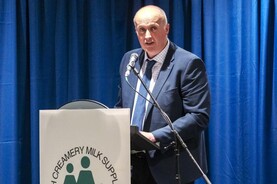Why pay for something when you can get it for free?
Last week, Minister for Agriculture Charlie McConalogue confirmed what the dogs in the streets have known for months – there will be no dairy cow cull scheme.
Farmers might accuse the Government of using nitrates derogation changes as a “dodgy box”– getting for free what they would otherwise have had to pay for.
It was entirely predictable that creeping environmental restrictions would curb overall cow numbers.
While the focus was initially on the climate action plan and its targets, nitrates was waiting in the long grass, and had its say last summer.
The sticking point for farmers seemed to be the sterilisation of land cows had been culled from for “new” or extra cows in another herd.
The ironic thing is, what a lot of farmers need now is extra land to keep the same number of cows by reducing stocking rate. And a dairy cow cull scheme might have been an avenue to allow that, had it been the focus of discussions.
While the IFA led farmer opposition to a reduction scheme, the dairy co-ops were also vehemently opposed to such a scheme. They even threatened legal action should the Government forcibly reduce the number of cows in the country.
It was understandable from their perspective – hundreds of millions has been invested in extra milk processing capacity, as part of a Government plan. And, now, a new Government plan would render some of that investment obsolete.
A cynic might point out that the chairs of Food Harvest 2020 and Food Wise 2025 were two former dairy executives, Seán Brady and John Moloney, who were always likely to be bullish about dairy expansion.
Individual farmers, who spent most of their working lives in a quota straitjacket, have been selling cows in serious numbers in recent months.
They saw the writing on the wall for a cow cull scheme, and jumped anyway. This paper has been talking to these farmers, and the tale is the same. No successor, a chronic shortage of full- and part-time labour, disillusionment with the ever ratcheting regulatory requirements, and the need for further investment in slurry storage are the factors leading farmers out. It’s likely that milk volumes won’t approach 2022 levels again anytime soon.
We’ve been here before. In January 2023, the minister said the following to the IFA’s environment conference in Limerick: “Both the farm organisations and the processors are in agreement that they do not want a beef reduction scheme, so that is something that is off the table.”
Difference
The big difference between the beef and dairy sectors is that we expect the beef barons to act in their own interests. But the dairy co-ops are farmer-owned, so suppliers’ interests must always be key in their minds.
Would a cow cull scheme have been a rational rationalisation? We’ll never know now.






 This is a subscriber-only article
This is a subscriber-only article










SHARING OPTIONS: